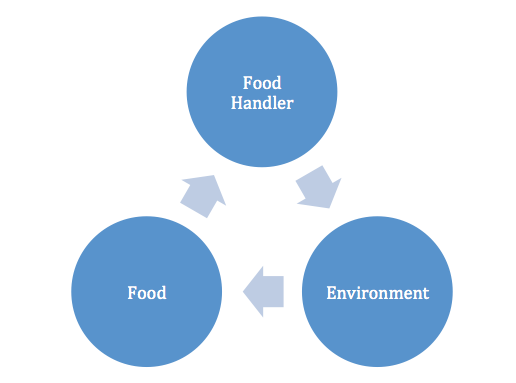1.1.4: Sanitation and Personal Hygiene
- Page ID
- 64279
Maintaining a clean work environment is critical in preventing foodborne illness. Bacteria can grow on unsanitary surfaces and then contaminate food. Just because a work surface looks clean does not mean that it is sanitary. Always ensure that you clean and sanitize a work area before starting to prepare food.
Cleaning Procedures and Schedules
Cleaning with soap and other detergents is just one step of the cleaning procedure. It is also necessary to sanitize. Cleaning will remove any dirt or grease, but will not necessarily kill any bacteria or other pathogens. Only a sanitizer will kill bacteria and ensure the area is safe for food preparation.
Developing a cleaning plan can help prevent the spread of foodborne pathogens and prevent an outbeak. Cleaning surfaces regulary will ensure a safe cooking environment. It is important to remember that just because it looks clean does not mean that it is free of harmful bacteria that could cause illness. Sanitizing of counter tops and cooking utensils is an important step in the cleaning process.
Routine Equipment Maintenance
All equipment must be routinely cleaned and inspected. Older equipment may have nooks and crannies where dirt and bacteria can hide, which can be difficult to clean effectively. Proper cleaning procedures must be established and followed at all times with regular review to ensure that procedures are working. If equipment is replaced or cleaning materials change, the process may have to be adjusted. Regular cleaning of equipment is also a good time to assess the equipment for any damage or wear and tear such as frayed cords, missing pieces, or broken parts. Keeping equipment clean and safe to use will prevent both illness and injury.
Importance of Personal Hygiene
It is imperative for safe food-handling outcomes for all workers to be familiar with standard sanitation and hygiene practices. Figure 6 shows the cycles of transmission of micro-organisms. One of the basic principles is to break the cycle by avoiding cross-contamination, which can be achieved by ensuring personal hygiene practices are followed.

Proper personal hygiene is critical in any food service premise. Personal hygiene includes:
- Showering and bathing regularly
- Keeping hair clean and covered or tied back
- Keeping clean clothing and footwear that is used only at work
- Handwashing regularly
- Using clean utensils for tasting food
- Using separate cloths for cleaning and wiping plates
Handwashing
Proper and regular handwashing is a critical part of any food safety system. You must always wash your hands after:
- Sneezing, coughing, or touching your mouth or nose
- Using the bathroom
- Smoking or using toothpicks
- Handling raw foods
- Cleaning and wiping tables, food preparation surfaces, or equipment
- Handling soiled objects, garbage, or money
The steps for proper handwashing are as follows:
- Wet hands with clean, running water and apply soap.
- Lather your hands by rubbing them together with soap.
- Scrub your hands for at least 20 seconds.
- Rinse hands under running water.
- Dry hands using clean towel or air drying them.

Use of Hand Sanitizers
Alcohol based hand sanitizers may be used in certain circumstances and can play a role in proper hand hygiene and reduce the spread of disease. Please view the following infographic from the CDC for more information:


